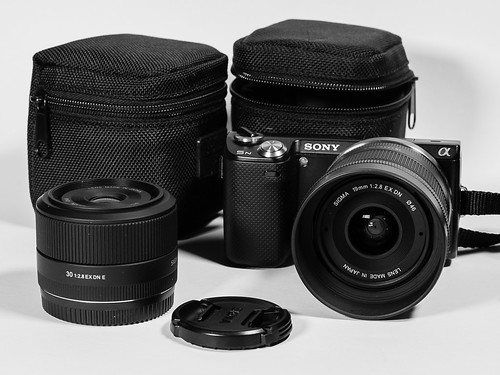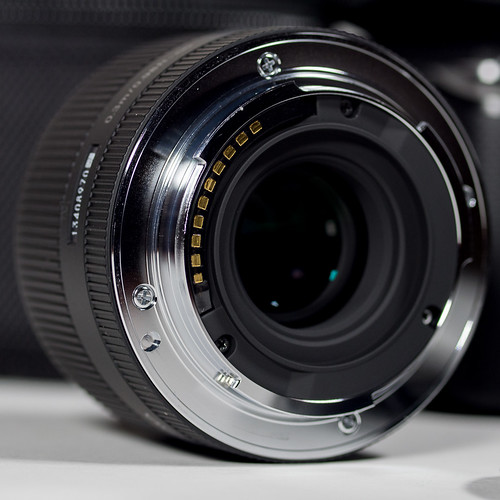Execution: 3 out of 5
Yeah, but: Never look a pair of gift lenses in the aperture.
The Long Version: I've been carrying two unique mirrorless camera systems for a while now. The first is µ4:3rds consisting of my µ4:3rds cameras (E-P2, E-PL1, E-PL2, and the OM-D E-M5) as well as a fair number of µ4:3rds lenses, some of which I've reviewed on this site. The other mirrorless camera system I've been carrying since late last year has been the Sony NEX, specifically the NEX-5N, which I picked up when it dropped precipitously in price right before the NEX-5R was announced (it has risen a bit in price since then).
So why did I buy the NEX-5N with all those other Olympus Pens lying about? Curiosity mainly. When I saw the low, low price of the 5N plus kit zoom, I figured the price was low enough to give the NEX a tryout. If it turned out bad I'd resell it and go on about my business. But the 5N turned out to be pretty good actually and so I kept it around. With regards to video it's turned out something close to phenomenal (but that's a review for another time).
Unlike the µ4:3rds system, I held back purchasing any other equipment for the camera beyond the 18-55mm kit lens the 5N was sold with. I wanted to investigate what the 5N was capable of on its own merits before making any kind of equipment expansion. While I was somewhat interested in the Sigma lenses when they were released for their still photography potential on the 5N, I was growing more interested in the 5N for its video capabilities and found the kit zoom to be more than adequate for my very modest video needs.
After their announcement the Sigma lenses began an inexorable slide in price, first down to $200/lens, then $150. Sometime around late January Sigma bundled both of them together for $199 ($99.50 each), which made the lenses irresistibly attractive to a cheapskate like me, so I bought them.
The bundle price was for both the µ4:3rds as well as E-mount versions. As luck would have it, the µ4:3rds sold out fairly quickly (that's where a good majority of the mirrorless camera enthusiasts seem to be) leaving plenty of E-mount lenses for the NEX system. I wouldn't have purchased the µ4:3rds versions because I already have those focal lengths pretty well covered with other lenses I own. From my perspective the 19mm and 30mm lenses make a lot more sense on the NEX body with its APS-C sensor; the 19mm gives an equivalent focal length of 28.5mm and the 30mm an equivalent focal length of 45mm. In other words, decent wide angle and normal primes.
The Problem With These Lenses
Before you go run off and buy copies of your own, you need to know the following:
- These particular lenses have been discontinued, which is why they've been chopped down in price so much. Sigma has officially stated that they will be replaced with "Art" versions of these lenses in the future. And if it's an Art lens, it will cost more.
- These lenses do not have built-in image stabilization. That means you'll need to work on your "camera technique", another way of saying you'll have to learn how to hold your camera steady in low light when aperture and ISO won't buy you a high enough shutter speed to be indifferently held. Tripods come to mind.
None of this will bother the true budget photographer. You'll purchase your copies, appreciate their value where others might not, and learn to use them regardless. While it could be argued their introductory MSRP might have been a tad too high, they're certainly worth what they're selling for now, which is one important reason I rate them as highly as I do.
The 19mm and 30mm have features which their more costly cohorts from other manufacturers lack at this price point, such as metal bayonets and lens hoods (at least a lens hood for the 19mm).
Both lenses use plastics quite heavily in their makeup, and both are blessed with quality metal bayonets. When I say they use plastics quite heavily, I mean that they spare nothing in the construction of the lens, especially the lens barrel itself. Both lenses are well-built and exude a level of fit and finish above their station.
And they are wonderfully black. I am so tired of seeing and/or buying silver and silvered lenses from Olympus and Sony. I hail from the Jurassic film period of 35mm photography, where every manly lens was metal and black anodized, with etched lettering everywhere. In these modern times the black anodized and etched metal has given way to industrial plastics with silk-screened lettering. I may grouse about the use of such, but I will at least grant that Sigma's use of silk-screened plastics is better than most (I'm looking at you Olympus and Sony).
Fitting one of these primes on the 5N produces a compact and enjoyable little camera system. The matte black finish of the Sigma lenses blends beautifully with the semi-gloss black finish of the 5N. The physical handling of the combination is superb. The operational handling (focusing and picture taking) is as good as the kit zoom. And this is why I like to have one or the other prime on the 5N instead of the zoom for still photography; at f/2.8, either lens' maximum aperture is 2/3rds to two stops wider than the kit lens at equivalent focal lengths. That's great for low-light photography.
Because the Sigma primes are black and smaller than the kit zoom, the overall combination is easier to carry and more inconspicuous in use. Even if you carry both primes with you (which I do), the total space occupied with the two primes plus the 5N is no more than the 5N with the kit zoom mounted. In practice I carry one prime in one pocket and the 5N with the other prime mounted slung over my shoulder or stuck in another jacket pocket.
That's it for now. In part two I will speak a bit more of their operation as well as display soul-searing (or is it eye-searing?) images made with the pair and the NEX-5N. In the mean time I leave you with this haunting image I made of poor Ruby, my yellow Lab, using the Sigma 30mm and the NEX-5N.
 |
| Oh, hell, not another test photo of me? One day you're going to stick a camera in my face and I'm going to grab it from you and bury it in the back yard where you can't find it. |
Technical
The hero photo at the top and the middle lens mount detail photo were taken with the Olympus E-M5 and the Zuiko Digital 50mm macro with the Olympus MMF-1 adapter. I used a pair of Fotodiox LED 312AS panels for lighting (thank you Kirk Tuck). Being lazy, I used the E-M5 instead of the E-1. And I mean lazy in that I didn't want to sit the camera on its tripod, use base ISO, and a very slow non-hand-holdable shutter speed. I hand-held the E-M5 and let it choose very high ISOs for both images (2500 for the top and 640 for the bottom). I have now put the E-1 away, and have no idea if I'll ever go back to it again.
last updated 16 feb 2013








I had fun reading your comments as I have been tempted by the sale price on these lenses. I too shoot both NEX and m43, so your analysis is (and will be on your next episode) especially interesting to me. Also, you write well.
ReplyDeleteBecause I find I am not too price sensitive I am tempted to wait until the "Art" models come out. I will be especially interested in the 60mm. If it is sharp wide open it will be a nice portrait lens on my NEX-6, as F2.8 is just about right in my opinion for portraits on a 1.5x crop system.
Anyway, I haven't been following the rumors on the announced "Art" Sigmas... Do you have any idea what is expected to make the new 19mm and new 30mm "better" than the discontinued $100 models?
Thanks!
According to Sigma, the A-For-Art version of this lens "represent[s] a new world of possibilities, helping photographers find the deeper essence of their art and increase their opportunities to express themselves."
ReplyDeleteIt also comes in either silver or black.